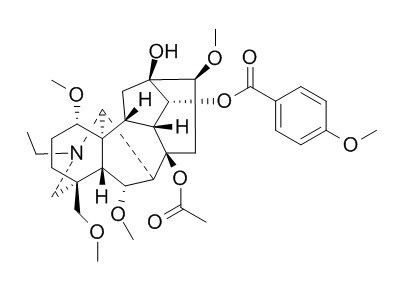Crassicauline A
Crassicauline A, a diterpenoid alkaloid in Aconitum herbs, is an analgesic drug clinically used in China. Crassicauline A possesses feeding deterrent activity against T. castaneum adults, with the EC(50) value of 1134.5 ppm.
Inquire / Order:
manager@chemfaces.com
Technical Inquiries:
service@chemfaces.com
Tel:
+86-27-84237783
Fax:
+86-27-84254680
Address:
1 Building, No. 83, CheCheng Rd., Wuhan Economic and Technological Development Zone, Wuhan, Hubei 430056, PRC
Providing storage is as stated on the product vial and the vial is kept tightly sealed, the product can be stored for up to
24 months(2-8C).
Wherever possible, you should prepare and use solutions on the same day. However, if you need to make up stock solutions in advance, we recommend that you store the solution as aliquots in tightly sealed vials at -20C. Generally, these will be useable for up to two weeks. Before use, and prior to opening the vial we recommend that you allow your product to equilibrate to room temperature for at least 1 hour.
Need more advice on solubility, usage and handling? Please email to: service@chemfaces.com
The packaging of the product may have turned upside down during transportation, resulting in the natural compounds adhering to the neck or cap of the vial. take the vial out of its packaging and gently shake to let the compounds fall to the bottom of the vial. for liquid products, centrifuge at 200-500 RPM to gather the liquid at the bottom of the vial. try to avoid loss or contamination during handling.
Industrial Crops and Products2024, 219:119123
Arch Toxicol.2024, 98(5):1415-1436.
Plant Physiol Biochem.2021, 160:166-174.
J Ethnopharmacol.2023, 317:116789.
Int J Mol Sci.2018, 19(9):E2528
J Microbiol Biotechnol.2022, 32(2):141-148.
Int J Biol Macromol.2018, 112:1093-1103
J Cell Mol Med.2023, 27(10):1423-1435.
Biomolecules.2019, 9(11):E696
Anal Biochem.2019, 569:10-15
Related and Featured Products
Talanta. 2012 Aug 15;97:491-8.
Measurement of yunaconitine and crassicauline A in small-volume blood serum samples by LC-MS/MS: tracing of aconite poisoning in clinical diagnosis.[Pubmed:
22841113]
Aconite poisoning is one of the most serious types of herb-related medical emergencies. In Hong Kong, many if not most of these poisoning cases are due to confusion in herbal species; that is, the wrong herbs are used in prescriptions. Such human errors, while inevitable perhaps, can be serious, and sometimes fatal. The chemical components responsible for aconite poisoning are yunaconitine and Crassicauline A.
METHODS AND RESULTS:
In the present study, a rapid and sensitive method for the screening and quantification of yunaconitine and Crassicauline A in human serum, using LC-MS/MS, was developed and validated. Methyllycaconitine was chosen as the internal standard. The limit of detection (LOD) of yunaconitine and Crassicauline A were found to be 0.022 and 0.021 ng/mL, respectively. The limit of quantification (LOQ) was 0.1 ng/mL for both yunaconitine and Crassicauline A. The recovery of yunaconitine and Crassicauline A ranged from 78.6% to 84.9% and 78.3% to 87.2%, respectively. The matrix effect of yunaconitine and Crassicauline A ranged from 110.0% to 130.4% and 121.2 to 130.0%, respectively. Both yunaconitine and Crassicauline A were stable in serum for at least 3 months at -20 °C, and the extracts were stable for at least 7 days. For clinical applications, serum samples of two patients confirmed to have had aconite herbs poisoning in 2008 were quantified using the developed method.
CONCLUSIONS:
The result showed that this method can be utilized in clinical routine applications. This screening method expedites the diagnosis in cases of suspected aconite poisoning, thus enabling doctors to treat the condition more quickly and effectively.
J Agric Food Chem. 2011 Apr 27;59(8):3701-6.
Feeding deterrents from Aconitum episcopale roots against the red flour beetle, Tribolium castaneum.[Pubmed:
21417277]
The screening for insecticidal principles from several Chinese medicinal herbs showed that the ethanol extract of Aconitum episcopale roots possessed significant feeding deterrence against the red flour beetle, Tribolium castaneum .
METHODS AND RESULTS:
From the ethanol extract, six feeding deterrents were isolated by bioassay-guided fractionation. The compounds were identified as chasmanine, Crassicauline A, karacoline, sachaconitine, talatisamine, and yunaconitine from their spectroscopic data. Chasmanine, talatisamine, karacoline, and sachaconitine exhibited feeding deterrent activity against T. castaneum adults, with EC(50) values of 297.0, 342.8, 395.3, and 427.8 ppm, respectively.
CONCLUSIONS:
Yunaconitine and Crassicauline A also possessed feeding deterrent activity against T. castaneum adults, with EC(50) values of 653.4 and 1134.5 ppm, respectively.
Chem Pharm Bull (Tokyo). 2009 Aug;57(8):801-7.
Structure-analgesic activity relationship studies on the C(18)- and C(19)-diterpenoid alkaloids.[Pubmed:
19652403]
For evaluation of C(18)- and C(19)-diterpenoid alkaloids as analgesics, three C(19)-diterpenoid alkaloids were isolated from the roots of Aconitum hemsleyanum var. circinatum and A. transsecutum; and twenty-five semisynthetic C(18)- or C(19)-diterpenoid alkaloids were prepared from lappaconitine, Crassicauline A or yunaconitine.
METHODS AND RESULTS:
In a mice acetic acid-induced abdominal constriction assay, four Crassicauline A analogs and three yunaconitine analogs exhibited good analgesic activities with 77.8-94.1% inhibition range in 0.1-10 mg/kg subcutaneous (s.c.) dose range at the point of 20 min after drug administration. Among them, 8-O-deacetyl-8-O-ethylCrassicauline A (ED(50)=0.0972 mg/kg) and 8-O-ethylyunaconitine (ED(50)=0.0591 mg/kg) were the most potent analgesics relative to the reference drugs lappaconitine (ED(50)=3.50 mg/kg) and Crassicauline A (ED(50)=0.0480 mg/kg).
CONCLUSIONS:
Analgesic activity data of these C(18)- and C(19)-diterpenoid alkaloids indicate that a tertiary amine in ring A, an acetoxyl or an ethoxyl group at C-8, an aromatic ester at C-14, and the saturation state of the ring D are important structural features necessary to the analgesic activity of the C(19)-diterpenoid alkaloids.



